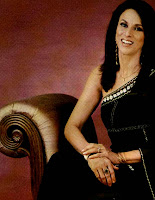
Craig Yu has taken the immediacy of photography and merged it with the artistry of old paintings to produce images that pose questions about our perception of the world. He tells P.Ramakrishnan how the meaning of anything can be changed by the way it is portrayed.
THEY LOOK LIKE blurred photographs, as if the cameraman forgot to focus before hitting click. The pictures are askew and their colours are inverted, appearing in strange hues of red, blue and black, almost monochromatic. I guess he forgot the flash as well.
But the 13 pieces on display at the Goethe Institut are all oil paintings on canvas. Craig Yu Yun-feng manipulates images from television and the internet to make a statement about context.
The 24-year-old artist photographs or downloads images, which, in the normal course of events, have been edited by media professionals before being shown. He then crops each picture and painstakingly recreates them on canvas. Some of his work is on display and for sale at the Arts Centre in Wan Chai.
"The general concept of my work is based around media influence, in and out of context - what happens to the meaning of everything when taken from its original context and put into a new one," says Yu.
The paintings have been sanded and thinned down to such a degree that there isn't any of the grainy oil-painting texture or clearly visible brush strokes to provide the aesthetic reassurance that what you see - such as the image of a soldier pointing a gun, ready to shoot - is just a picture.
"The images are from various documentaries, some of them taken from the Discovery channel, local stations in Hong Kong or the media in the US," says Yu. "I manipulate them in a way to make it more ambiguous. The imagery becomes more abstract when it gets on the canvas.
"In the painting Fire And Forget, the image was taken from a documentary on the Israeli-Palestinian conflict. I was interested in the way they focused a lot more on military technology and how to win their battles rather than focusing on the actual conflict and what happens to the people. The people didn't matter."
The same can be said of the artist when people become blurs, gossamer light visions, who almost completely disappear into the background. "You don't see people in the picture because that's not really my focus in general but more on how people perceive the image of people or things. That's why a lot of the time you can't make out exactly what they are."
His use of primary colours is very particular. "Red is to show infra-red, heat-seeking or heat-reflecting images," he explains. "Blue is used to show night vision, dark imagery. I'm not in a blue mood or anything like that, but want to show technology in an aesthetic way. The environment that you see and its various distortions is my focus."
Hence the title of the current exhibition, Milieu Perversions. A more disturbing heading than Yu's earlier solo exhibition, City Of Light, which was on display at Arts in China. Remnants of the earlier theme are visible perhaps only in the 1.2 square metre painting in the corner, entitled Neon Distraction. Again, it looks like a vision of Wan Chai seen through beer goggles.
"Neon Distraction is about too much information. Hong Kong is very advertisement-driven. How you subconsciously take it all in. You look at it and think, 'here's this advertisement that's coming at me and I can't get away from it'. Every square inch of town just seems sponsored by something," says Yu, who's lived here for more than a decade but is still bemused by it.
It's difficult to argue with Yu on the frenzy of local marketing. Take a trip through Causeway Bay and every building seems to be slapped with skyscraper-sized ads of beer, make-up, jewellery, colas, gym-membership, watches and fashion labels. Everything that you evidently need or couldn't possibly have enough of. "It's true of advertising anywhere and everywhere but when I'm in Hong Kong, I feel it's much more pressured. You lose perception of where you are," says Yu.
"Neon Distraction was a piece that I started before I did any of the other pieces. My earlier work was generally about Hong Kong while this current exhibition is thematically different. At the same time, it relates to this exhibition because it has to do with advertising which is essentially to do with perception of images." Isn't the politicised subtext going to be lost in Hong Kong? "It's such a financially driven place - how a war would affect the stock market or the economy," Yu says. "That's what the focus is on. But look at what happened on Tuesday [in the 500,000-strong protest against the proposed national security law]. For four straight hours from Causeway Bay to the Government offices I walked with thousands and thousands of people. I was completely surprised at the turnout. It was so impressive."
Then why not just post photographs of what is the most disturbing or manipulative and then enlarge, crop and frame? Why not show reality without the paint and subtext routines?
"I'm not just using the oil paint for the sake of it, because I like the aesthetic," Yu continues. "It goes well with the kind of imagery that I'm trying to show. Pictures taken from television or the internet are the most technologically advanced way of showing images. I'm then taking that completely out of context and going back into one of the most historic ways of showing imagery, which is oil painting."
Milieu Perversions runs until July 16 at Goethe Gallery, 14/F, Hong Kong Arts Centre, 2 Harbour Road, Wan Chai. Mon-Fri, 9am-9pm. Sat 2pm-6pm. Inquiries: 2829 9916.



















